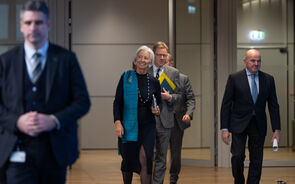Stephen Roach - pessimista cansado
4 mensagens
|Página 1 de 1
Stephen Roach - pessimista cansado
O Sr. Roach está a vacilar (está cansado..diz ele).
Depois de um tremendo bear market (que ainda está em pleno), das crises que já preduram há anos, do terrível 11 de Setembro, de uma guerra muito vivida em cima dos acontecimentos, é normal sentir-se uma certa saturação, e começar a pensar: será que isto nunca mais acaba ?
Será que alguns dos problemas mais evidentes da economia começam a ter uma luzinha ao fundo do túnel? Não me parece.
Penso que toda esta pessegada se irá curar com o teeeeeempo. Não há receitas milagrosas.
Bom dia, e um abraço para Vocês .
------------------------------------------------------------------
Global: A Pessimist's Lament
Stephen Roach (New York)
I’m tired of being so negative on the macro outlook. We all are. But I must confess it’s finally starting to get to me, purportedly one of the most bearish of the lot. It’s not that I’ve lost my sense of conviction. It’s actually a more disturbing thought -- that after all these years, I’m starting to sense that no one is really listening.
Sure, financial markets have been in a three-year funk -- a huge post-bubble correction in world equity markets and an equally extraordinary surge in bonds. Over the same time frame, the global economy has been in one recession and is back on the brink of another one right now (see my April 4 dispatch, “The Global Double Dip”). Yet convictions are still deep that these disruptions are temporary, not systemic, and that they have now gone on for long enough. As such, most investors, policy makers, and politicians remain convinced that mean reversion is imminent -- that fundamental macro relationships are about to return to their longer-term trends. Over the years, these are the gut feelings I have learned to respect the most. And yet now I find myself at odds with those very instincts. That troubles me. It forces me to ask myself repeatedly these days -- what am I missing?
For starters, maybe I’m just using the wrong macro framework. As has been the case for some time, my vantage point continues to be defined by two overarching forces -- a US-centric global economy and a post-bubble US economy. In this stylized construct of the world, the global call boils down to a US call. Lacking in any alternative sources of domestic demand, the wherewithal of the American growth engine continues to call the tune for the global prognosis. That’s pretty much the way it’s been since 1995, but maybe I’m wrong in failing to recognize the emergence of new sources of global growth. But then I run through the list of candidates: Europe and Japan don’t exactly jump off the page these days. Nor does Asia ex Japan or crisis-torn Latin America. Eastern and Central Europe are too small, as are Canada and Australia. China is the closest thing to a new source of global growth but I continue to believe that the Chinese impetus is likely to remain focused more on the supply side than on the demand side of the global economy. The sudden emergence of the Chinese consumer would admittedly send me back to the drawing boards. But as Morgan Stanley’s most ardent China bull, even I don’t see that one coming for years (see my April 2 dispatch, “China -- Externally or Internally Driven?”).
Which takes us to the major source of debate in a US-centric world, the outlook for the US economy. My operative model of America remains that of the post-bubble workout -- that the US economy still has considerable distance to travel in purging the excesses that built up in the latter half of the 1990s. Three excesses worry me most in this regard: low national saving, high private sector indebtedness, and a massive balance of payments deficit. On all three counts, the excesses now stand at all-time records for the post-World War II US economy. Given these excesses, as well as a lack of pent-up demand for items such as cars, homes, and new capacity, I remain convinced that policy traction will remain disappointing -- that the US economy will fail to respond to monetary and fiscal ease as it normally does. Like the authorities in Tokyo, Washington is experiencing the classic post-bubble frustrations of “pushing on a string.”
The counter to this is that America has already atoned for many of its sins. That’s especially true of the corporate sector, where balance sheet restructuring is advanced, capacity excesses have been purged, and earnings are on the mend. This has given rise to the notion that the US could actually be on the brink of a capex-led recovery. If that’s the case, I will be certainly be shocked (see my March 5 dispatch, “Capital Spending Myths”). Not only does my work show that business capital spending never leads a cyclical upturn, but it also challenges the notion that there would be any demand for new capacity in a world lacking in pricing leverage and awash in excess supply.
But maybe there’s more to America’s growth potential -- one last surge from the housing sector, a war-related burst of defense outlays, or yet another resurgence of demand from the seemingly insatiable American consumer. I can’t rule out any of those possibilities. But if I’m going to be wrong, my suspicion lies with the consumer. I continue to see the aging American consumer as saving-short, overly indebted, and just about tapped out of the wealth effects from equities and property. Moreover, I continue to worry that the pendulum of corporate cost-cutting is about to swing toward the slashing of excess labor costs -- especially the long-overdue pruning of managerial bloat. That would hit the income stream just when households have extracted the final drops of purchasing power from their overvalued assets. But the American consumer has long defied the doubters, and maybe that’s exactly what I’m missing in my own downbeat assessment.
There’s a final element of my macro framework -- the linkages between America and the remainder of a US-centric world economy. To me, this is where the rubber meets the road for a saving-short US economy and a demand-deficient global economy. The US national saving outlook is quickly going from bad to worse. Net of depreciation, the national saving rate -- for consumers, businesses, and the government sector -- fell to a record low of 1.3% in the second half of 2002. Moreover, with the federal budget situation now deteriorating dramatically -- deficits of $400 billion can no longer be ruled out over the next few years -- the net national saving rate can only fall further. And that could well be the tripwire for a dysfunctional world.
The new generation of supply-siders in the White House and the Congress could care less. Yet these are the budget deficits -- and the drain on national saving -- that leave America with no choice other than to import ever-larger amounts of surplus saving from abroad in order to keep the US economy running. And, of course, the only way to attract this foreign capital is to run ever-widening balance of payments deficits. That, in turn, suggests that the US current account deficit, which hit a record 5.2% of GDP in late 2002, could be headed toward 7% by 2004 -- and possibly even higher in the years beyond. To me, that’s the height of instability for the financial underpinnings of the global economy -- an outcome that can only end with a sharp decline in the dollar. This, in fact, is the catalyst of the “global rebalancing” I have long envisioned -- currency adjustments that inhibit domestic demand in the US and curtail external demand in the rest of the world. Pro-growth stimulus in the non-US world then becomes the only option.
Here’s where I believe nobody really seems to care. America has had an ever-growing balance-of-payments deficit for most of the past 20 years and it hasn’t been much of a problem -- either to the US or to the rest of the world. What I’m missing, the critique goes, is that there’s nothing wrong with this arrangement. Lacking in demand of its own, the world has, in effect, been perfectly content to finance the profligacy of a saving-short US economy.
I have to confess that it’s at this point where I just lose it. I have the same problem with this logic that I did with bubblenomics in the late 1990s. Just because imbalances and excesses endure for longer than fundamentals suggest doesn’t mean we have the fundamentals wrong. Conversely, it may well mean that financial markets simply have asset valuation wrong -- that today’s dollar bubble is nothing more than the functional equivalent of the Nasdaq bubble some three years ago. To me, this is the most glaring example of a dysfunctional world. What concerns me most is that there’s nothing stable about the current imbalances in the global economy. Courtesy of a rapidly deteriorating US saving position, these imbalances can only get worse until something gives. I guess what I must be missing is the infinite tolerance of an ever-elastic US-centric world.
“It’s all the war” is the most common refrain I hear these days. In a postwar world, the argument goes, the combination of lower oil prices and a diminished “uncertainty factor” should provide a sharp boost to today’s weakened global economy. At that point, the combination of policy traction and the animal spirits of pent-up demand are expected to kick in -- precisely the opposite of what I expect and yet the perfect antidote to the angst that is currently gripping the world. I have no problem with the concept of postwar relief. But I have yet to figure out how it heals what is truly ailing a dysfunctional global economy. That’s the quick fix that I guess I must be missing.
Depois de um tremendo bear market (que ainda está em pleno), das crises que já preduram há anos, do terrível 11 de Setembro, de uma guerra muito vivida em cima dos acontecimentos, é normal sentir-se uma certa saturação, e começar a pensar: será que isto nunca mais acaba ?
Será que alguns dos problemas mais evidentes da economia começam a ter uma luzinha ao fundo do túnel? Não me parece.
Penso que toda esta pessegada se irá curar com o teeeeeempo. Não há receitas milagrosas.
Bom dia, e um abraço para Vocês .
------------------------------------------------------------------
Global: A Pessimist's Lament
Stephen Roach (New York)
I’m tired of being so negative on the macro outlook. We all are. But I must confess it’s finally starting to get to me, purportedly one of the most bearish of the lot. It’s not that I’ve lost my sense of conviction. It’s actually a more disturbing thought -- that after all these years, I’m starting to sense that no one is really listening.
Sure, financial markets have been in a three-year funk -- a huge post-bubble correction in world equity markets and an equally extraordinary surge in bonds. Over the same time frame, the global economy has been in one recession and is back on the brink of another one right now (see my April 4 dispatch, “The Global Double Dip”). Yet convictions are still deep that these disruptions are temporary, not systemic, and that they have now gone on for long enough. As such, most investors, policy makers, and politicians remain convinced that mean reversion is imminent -- that fundamental macro relationships are about to return to their longer-term trends. Over the years, these are the gut feelings I have learned to respect the most. And yet now I find myself at odds with those very instincts. That troubles me. It forces me to ask myself repeatedly these days -- what am I missing?
For starters, maybe I’m just using the wrong macro framework. As has been the case for some time, my vantage point continues to be defined by two overarching forces -- a US-centric global economy and a post-bubble US economy. In this stylized construct of the world, the global call boils down to a US call. Lacking in any alternative sources of domestic demand, the wherewithal of the American growth engine continues to call the tune for the global prognosis. That’s pretty much the way it’s been since 1995, but maybe I’m wrong in failing to recognize the emergence of new sources of global growth. But then I run through the list of candidates: Europe and Japan don’t exactly jump off the page these days. Nor does Asia ex Japan or crisis-torn Latin America. Eastern and Central Europe are too small, as are Canada and Australia. China is the closest thing to a new source of global growth but I continue to believe that the Chinese impetus is likely to remain focused more on the supply side than on the demand side of the global economy. The sudden emergence of the Chinese consumer would admittedly send me back to the drawing boards. But as Morgan Stanley’s most ardent China bull, even I don’t see that one coming for years (see my April 2 dispatch, “China -- Externally or Internally Driven?”).
Which takes us to the major source of debate in a US-centric world, the outlook for the US economy. My operative model of America remains that of the post-bubble workout -- that the US economy still has considerable distance to travel in purging the excesses that built up in the latter half of the 1990s. Three excesses worry me most in this regard: low national saving, high private sector indebtedness, and a massive balance of payments deficit. On all three counts, the excesses now stand at all-time records for the post-World War II US economy. Given these excesses, as well as a lack of pent-up demand for items such as cars, homes, and new capacity, I remain convinced that policy traction will remain disappointing -- that the US economy will fail to respond to monetary and fiscal ease as it normally does. Like the authorities in Tokyo, Washington is experiencing the classic post-bubble frustrations of “pushing on a string.”
The counter to this is that America has already atoned for many of its sins. That’s especially true of the corporate sector, where balance sheet restructuring is advanced, capacity excesses have been purged, and earnings are on the mend. This has given rise to the notion that the US could actually be on the brink of a capex-led recovery. If that’s the case, I will be certainly be shocked (see my March 5 dispatch, “Capital Spending Myths”). Not only does my work show that business capital spending never leads a cyclical upturn, but it also challenges the notion that there would be any demand for new capacity in a world lacking in pricing leverage and awash in excess supply.
But maybe there’s more to America’s growth potential -- one last surge from the housing sector, a war-related burst of defense outlays, or yet another resurgence of demand from the seemingly insatiable American consumer. I can’t rule out any of those possibilities. But if I’m going to be wrong, my suspicion lies with the consumer. I continue to see the aging American consumer as saving-short, overly indebted, and just about tapped out of the wealth effects from equities and property. Moreover, I continue to worry that the pendulum of corporate cost-cutting is about to swing toward the slashing of excess labor costs -- especially the long-overdue pruning of managerial bloat. That would hit the income stream just when households have extracted the final drops of purchasing power from their overvalued assets. But the American consumer has long defied the doubters, and maybe that’s exactly what I’m missing in my own downbeat assessment.
There’s a final element of my macro framework -- the linkages between America and the remainder of a US-centric world economy. To me, this is where the rubber meets the road for a saving-short US economy and a demand-deficient global economy. The US national saving outlook is quickly going from bad to worse. Net of depreciation, the national saving rate -- for consumers, businesses, and the government sector -- fell to a record low of 1.3% in the second half of 2002. Moreover, with the federal budget situation now deteriorating dramatically -- deficits of $400 billion can no longer be ruled out over the next few years -- the net national saving rate can only fall further. And that could well be the tripwire for a dysfunctional world.
The new generation of supply-siders in the White House and the Congress could care less. Yet these are the budget deficits -- and the drain on national saving -- that leave America with no choice other than to import ever-larger amounts of surplus saving from abroad in order to keep the US economy running. And, of course, the only way to attract this foreign capital is to run ever-widening balance of payments deficits. That, in turn, suggests that the US current account deficit, which hit a record 5.2% of GDP in late 2002, could be headed toward 7% by 2004 -- and possibly even higher in the years beyond. To me, that’s the height of instability for the financial underpinnings of the global economy -- an outcome that can only end with a sharp decline in the dollar. This, in fact, is the catalyst of the “global rebalancing” I have long envisioned -- currency adjustments that inhibit domestic demand in the US and curtail external demand in the rest of the world. Pro-growth stimulus in the non-US world then becomes the only option.
Here’s where I believe nobody really seems to care. America has had an ever-growing balance-of-payments deficit for most of the past 20 years and it hasn’t been much of a problem -- either to the US or to the rest of the world. What I’m missing, the critique goes, is that there’s nothing wrong with this arrangement. Lacking in demand of its own, the world has, in effect, been perfectly content to finance the profligacy of a saving-short US economy.
I have to confess that it’s at this point where I just lose it. I have the same problem with this logic that I did with bubblenomics in the late 1990s. Just because imbalances and excesses endure for longer than fundamentals suggest doesn’t mean we have the fundamentals wrong. Conversely, it may well mean that financial markets simply have asset valuation wrong -- that today’s dollar bubble is nothing more than the functional equivalent of the Nasdaq bubble some three years ago. To me, this is the most glaring example of a dysfunctional world. What concerns me most is that there’s nothing stable about the current imbalances in the global economy. Courtesy of a rapidly deteriorating US saving position, these imbalances can only get worse until something gives. I guess what I must be missing is the infinite tolerance of an ever-elastic US-centric world.
“It’s all the war” is the most common refrain I hear these days. In a postwar world, the argument goes, the combination of lower oil prices and a diminished “uncertainty factor” should provide a sharp boost to today’s weakened global economy. At that point, the combination of policy traction and the animal spirits of pent-up demand are expected to kick in -- precisely the opposite of what I expect and yet the perfect antidote to the angst that is currently gripping the world. I have no problem with the concept of postwar relief. But I have yet to figure out how it heals what is truly ailing a dysfunctional global economy. That’s the quick fix that I guess I must be missing.
- Mensagens: 195
- Registado: 11/12/2002 2:48
- Localização: Paço de Arcos
4 mensagens
|Página 1 de 1
Quem está ligado:
Utilizadores a ver este Fórum: Google [Bot], latbal, lsmsimoes9, nbms2012, Opcard33, trilhos2006 e 240 visitantes



